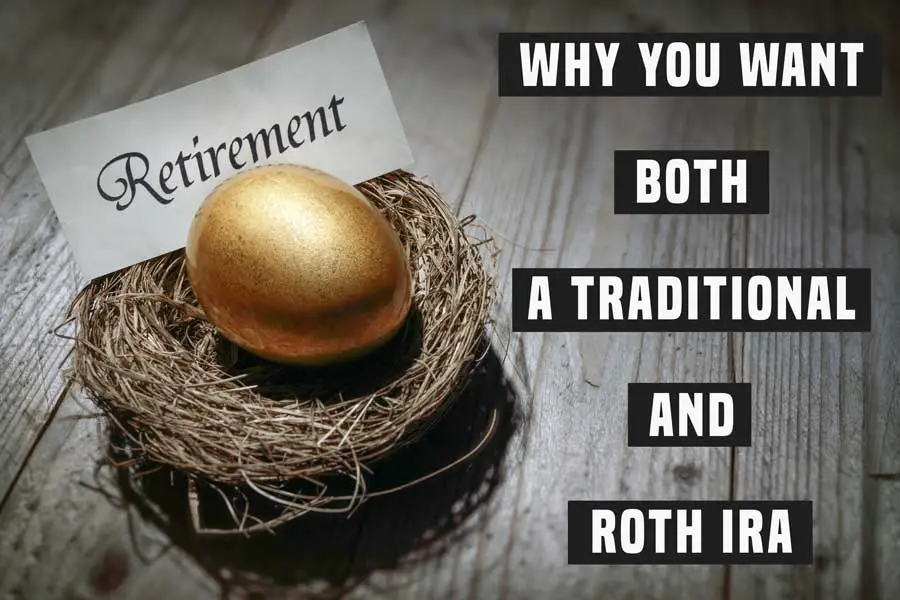Investing only in a Roth Account is not the only way to avoid taxes in retirement. You can still pay little or even NO taxes by withdrawing a portion of your money from a Roth account and another portion from a Traditional account. This is done by taking advantage of the standard deduction and lower tax brackets. Having both of these accounts in the long run will provide you with greater flexibility and tax savings.
The Difference Between A Roth And A Traditional Account
A very quick overview. Traditional style accounts, such as a Trad IRA or a 401k, you are getting the benefit up front. In these accounts you are reducing your taxable income. The benefit of these accounts become very clear as you move up into the 22% tax bracket and beyond.
That means on a $1,000 contribution in the 22% bracket, you are saving $222.
Well kind of…
You still have to include that money in your taxable income when you pull it out in retirement. However, just because you have to include it in your income does not mean you will owe any taxes. If your income is low enough you will not have to pay anything in taxes because the standard deduction will reduce your income down to zero.
Roth accounts have you pay taxes up front with the promise that you will be able to grow that money tax free and withdraw it in retirement tax free. Withdrawals do not increase your taxable income and don’t move you into higher tax brackets.
Why Some People Say To Put All Your Money In A Roth IRA
People like to say this because it is simple, and doesn’t involve any number crunching or lengthy explanations. Once you explain how a Roth works, pretty much everyone understands how it is possible to be “A tax free millionaire”. It definitely works, its just not the optimal way.
Good tax & financial advisors have many simple strategies they use to save their clients money and using a Traditional IRA is one of them. They are very aware of Roth IRAs and use those too, but they are constantly still utilizing Traditional accounts because they know, in the long run, it is best for their client.
When people say “Roth only” they are usually overlooking the benefits of a Traditional account or are trying to create a catchy simplified message that will resonate with people.
How Having A Traditional IRA Will Save You Money
We have already established that a Traditional account is going to save you money upfront every year you make a contribution by reducing your taxable income. I will now give an example of how having both accounts is better then just having a Roth. This is done by factoring in that we still get the standard deduction in retirement.
Here is a simple example of how a huge tax benefit could be missed by people who go the Roth only route.
A married 61 year old couple withdraws $50,000 out of their Roth IRA and have no other income.
How much do they pay income taxes? zero!
How much of their standard deduction did they use? zero!
A second 61 year old married couple pulls out $25,000 from a Roth and $25,000 Trad IRA. With no other income.
How much do they pay in taxes? zero!
How much of their standard deduction did they use? $25,000.
They both pay zero! They both had the same outcome because of the standard deduction. The difference is that the second couple will have saved thousands of dollars in taxes over their life by making Traditional contributions.
Lets say that both couples contributed $200,000 to their accounts over the years.
Couple one, put all their money into Roth accounts and paid the taxes every year.
Couple two on the other hand, put a $100,000 into their Roth, and $100,000 into their Traditional account. They paid the taxes on the money that went into the Roth, but were able to deduct the money that went into the Traditional.
If couple two was in the 22% tax bracket, when they made these contributions, that means they would have saved $22,000 in taxes.
Every persons situation is unique, and you will need to actually look at your own personal financial situation to make the best choice. However, with the knowledge and realization that you want to use your standard deduction in retirement, you will likely consider not using the Roth only approach .
How Having A Roth And A Trad Provides Flexibility
By having both account types you can adjust your taxable income up and down. While we mostly want that number to come down, there are actually times when you may want that number to adjust up. Example, to take advantage of the standard deduction.
Lets say that you say you leave your job to start a business, during this time you are living off of savings, and you only made $3,000 your first year after expenses.
Now, could be a perfect opportunity for a Roth Conversion.
You have a bunch of money put away in a Traditional IRA, maybe by rolling over an old 401k. You can convert that money over into a Roth account by following the instructions on your brokers website or by talking with your financial advisor.
If you want to pay no taxes on the conversion, you must find out how much of your standard deduction you will have left at the end of the year and only convert that much.
Or…
You are fine with paying some taxes, and figure out how much you can convert staying in the 10% bracket. This seems like a great deal to you, because you usually pay 22% tax on your Roth contributions.
A personal example, My husband and I have used the flexibility of these accounts to qualify for a health insurance subsidy.
We were starting our business, and in the first year we did not make very much money. We had HSA’s (Health Saving Accounts) that we wanted to contribute to, but after we did that it put us below the income needed to receive affordable health insurance without jumping through a bunch of hoops. So, to bring our income back up to a level where that wouldn’t be necessary, we converted money from a Traditional account to a Roth. Problem adverted!
Having Both A Roth And Traditional IRA
Traditional and Roth IRAs provide greater flexibility and tax savings when used together. Having both allows you to take full advantage of tax deductions, conversions, and tax-free income. Most people will be able to save more money over the long term by using both with an appropriate plan.
I hope you found this helpful! If you are unsure of what steps you need to take for your personal situation, reach out to your local tax & financial professional.

